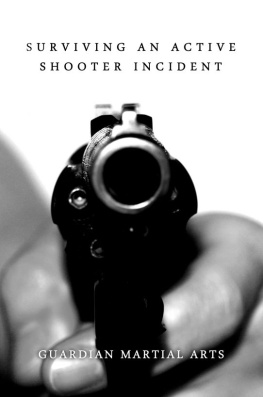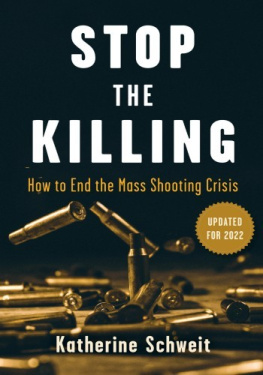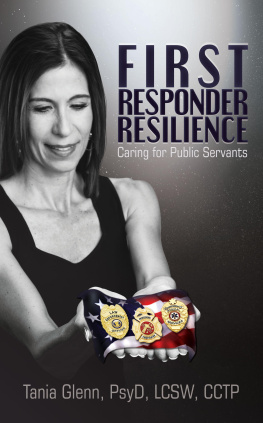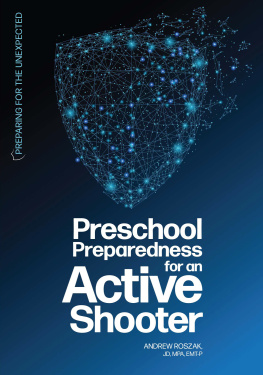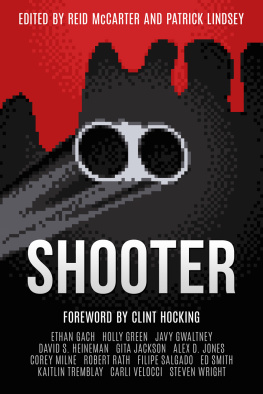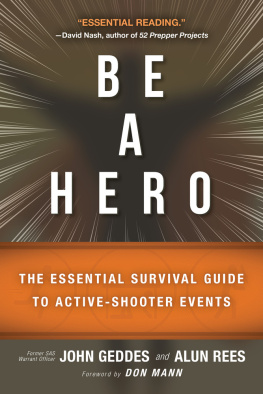Surviving an Active ShooterIncident
By Anthony Horvath
Smashwords Edition
This ebook is licensed for your personalenjoyment only. This ebook may not be re-sold or given away toother people. If you would like to share this book with anotherperson, please purchase an additional copy for each recipient. Ifyoure reading this book and did not purchase it, or it was notpurchased for your use only, then please return to Smashwords.comand purchase your own copy. Thank you for respecting the hard workof this author.
Copyright Guardian Martial Arts 2012. AllRights Reserved
Cover by Julius Broqueza.
Contents
INTRODUCTION
Since the Columbine school shootings, 'activeshooters' have become a grave concern in American society. Whilestatistically such incidents are rare, they occur often enough tobe a regular news item. The shootings we hear about most tend to bein schools, but there have been 'mass casualty' events in othersettings as well, such as in the workplace or in diners. The eventsare common enough that protocols have been developed. Theseprotocols tend to address these situations from the perspective oflaw enforcement and school administrators, with the advice topotential victims reducing essentially to "hide and hope."
This guide is written the other way around,emphasizing strategies and tactics those in the line of fire canuse to survive the incident.
For example, from the perspective of firstresponders, it is surely a great help to them if the innocentvictims are all hiding under desks and not running about, but doesanyone expect people to sacrifice their lives just so that thegunman stands out clearly from the background? Or, to put itanother way, active resistance to an active shooter is notrecommended--yet it can be argued that a number of tragedies couldhave been averted or minimized if people had fought back. Indeed,the reader can probably think of some examples where this wastried, most notably the passengers of Flight 93 on 9-11.
Granted, in this case, they all died, but theirsacrifice likely saved the lives of thousands of others. But notehow in the 'protocol' for hostage situations was actuallymanipulated by the aggressors in this instance. That 'protocol' isbased on some critical assumptions, namely that the hostage takersactually hope to survive the event themselves!
Guardian Martial Arts seeks to equip people to defendthemselves and those they love, so this guide is geared towards theindividual finding themselves in a dire situation and giving themadvice on how to survive the event. It may or may not matchperfectly what the first responders would like you to do; but then,it is your own life on the line.
That said, the reader should make themselves aware ofthe protocols that are out there, as it isn't for no reason thatlaw enforcement experts have adopted them.
CONSTANTVIGILANCE
Strictly speaking, it is impossible to be prepare forevery situation that arises, if only because the gunmen involved inthese incidents are not always mentally stable and rationale. Infact, wouldn't you say that if they go on a rampage, that isalready proof positive that they don't have it all together? Youmay simply be at the wrong place at the wrong time. Think of theWashington DC Sniper case. There is virtually no way to prepare forthat sort of scenario.
Nonetheless, there is good reason to expect that ifshots ring out, you will have at your disposal some options toexercise. Provided that you have mentally prepared yourself, youwill not panic, but instead will act intelligently.
This mental preparation is your first line of defenseagainst all kinds of danger, not just active shooters. Being awareat all times of your surroundings and the people around you willprovide you with valuable information about your potential exposureto harm. Making note of your available exits as soon as you enter abuilding is good to know, whether shooting starts or a fire breaksout. Performing at least a cursory 'threat analysis' of each personthat comes within your range is something you should train yourselfto do.
Law enforcement is trained not to profile. You areunder no such orders. If you see someone that makes youuncomfortable, for whatever reason, you should at least make amental note. Trust your instincts. At the same time, there are goodreasons why law enforcement shies away from 'profiling.' If youhave fixed in your mind some idea of what a 'dangerous person'looks like, you may be oblivious to the threat the reallydangerous person in the area poses, because he doesn't meet yourcriteria for 'dangerous looking.'
If you are mentally prepared to be constantlyvigilant, you will take into account the fact that appearances donot tell the whole tale, and attempt to do a quick look-over ofeveryone in the vicinity.
While actual training in the detection of suspiciousbehavior would be a huge asset, many of the signs of a dangerousindividual are within the realm of common sense. You just need anobservant mindset.
Potentially dangerous people may exhibit:
- Refusing to make eye contact
- Excessive perspiration
- Pacing to and fro
- Trembling and shaking and other nervousbehavior
In other words, people acting out of the ordinary,regardless of how they look, is cause for concern.
An example might be the man wearing a bulky, heavywinter coat on a hot day. This person might be a suicide bomber enroute to make trouble. This raises the important point that thereare many kinds of threats out there that require you to beconstantly aware of your surroundings. An active shooter is the onein view in this guide. A suicide bomber is (currently) extremelyunlikely, but muggers and rapists and the like can be found justabout anywhere.
Educating yourself on the different kinds ofbehaviors that are potentially associated with different kinds ofdangerous outcomes would be an excellent compliment to your'constant vigilance' stance.
Obviously, in the event of an active shooter, thebehavior is probably going to be instantly clear: he's waving a gunaround and shooting people.
However, being in the 'wrong place at the wrong time'could be turned into being in the 'right place at the right time'if you recognize that someone is acting suspiciously and callappropriate attention to it--after, we hope, you secure your ownsafety.
ESCAPE
Unless you are a law enforcement officer, your firsttactic should be to try to make an escape.
It is for this reason that you want to always makenote of your exits. When possible, position yourself to be nearthem at all times, like for example the booth in the restaurantnearest the exit sign. Bear in mind, however, that being near anexit potentially puts you near the active shooter'sentrance.
Sometimes it is possible to create your own exit,like, for example, breaking through an exterior window. Being alertto items in the vicinity that could aid you in that effort would bewise.
Some general guidelines for making your escapeinclude:
- Leave even if no one else comes with you.
- Forget your stuff.
- Keep your hands visible as you make your exit.
Remember, this guide is geared towards maximizingyour chances for survival. Obviously, if you are able to helpothers escape, or can warn others away from the danger zone, thatwould be good.
Don't wait to win consensus from those around you.Remove yourself from the scene as quickly as you are able,regardless of whether or not anyone else comes along. Others aroundyou may have fallen into a state of panic, and may instinctivelychoose to hunker down. Since you were in a state of constantvigilance when everything hit the fan, you, on the other hand, knowwhere your exits are and had a plan on how you were going to getthere. So, get there.
Leaving your belongings obviously allows you to moveunencumbered, but it has the very good side benefit of allowing youto show arriving police officers that your hands are empty as youmake your escape. Preferably, you do not want to escape the madmancutting people down behind you only to be cut down by respondingpolice officers who may or may not know what the real gunman lookslike.
Next page
